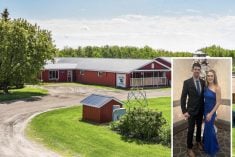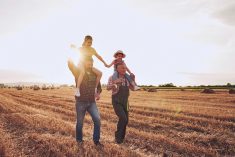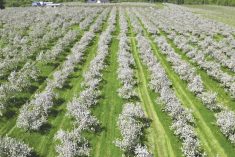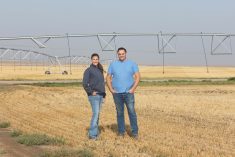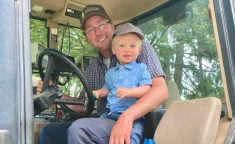More than 1,000 18- to 25-year-olds from 95 countries submitted essays to qualify for the third Youth-Ag Summit held this past October in Belgium, with 100 delegates actually getting a ticket.
Among them were four young Canadians. Sponsored by Bayer, the summit gave youth an opportunity to discuss one of the most pressing questions the world will face for years to come: How do we continue to feed everyone, especially as the population continues to grow?
The summit was based on the premise that bringing together bright young minds who are already studying and working in agriculture and food around the world is one way to get closer to an answer.
Two of the Canadians who attended the summit — Cameron Olson of Calgary, Alta, and Alexis Wagner originally of Guelph, Ont. — have two different approaches to thinking about the question of the future of food.
Even so, it turns out they think alike in one very important way. Both are getting a wider picture than their parents did at the same age because, like many young people today, they travel widely.
It makes a difference.

From the West, Cameron Olson, who grew up on a farm southeast of Calgary, articulates the kind of youth perspective shared by many of today’s young farmers. Olson spent nine years of his youth involved in the Alberta 4-H program, which, he says, nurtured his interest in beef cattle research.
Olson applied to become a delegate for the Youth-Ag Summit because he was interested in the fact that “they were inviting people who had an interest in agriculture, not necessarily people who were in agriculture.” Because of this, he says, he saw an opportunity to “learn from different perspectives, different backgrounds — from political science majors to entrepreneurs.”
Olson, for his part, has completed both a bachelor’s and a master’s degree in animal science at Texas A&M University. This January he started a PhD in animal science at the University of Alberta and ultimately wants have a career in private industry research in beef cattle nutrition and management.
Read Also

Youth focused on keeping Quebec’s dairy industry strong
In part two of our Making the Future series, Country Guide spoke with Béatrice Neveu from Rawdon, Que. (Read part…
On the side, he’d “like to have a moderately sized herd of cattle,” somewhere in southern Alberta.
There are many new technologies available in the beef industry, but sometimes they can be slow to get to implementation. New processes, both natural and pharmaceutical, that mitigate methane production, for example, can help with efficiency and are “less environmentally impactful, which enables producers to feed more cattle and produce more beef per animal,” Olson says.
Another issue that comes up on a more global scale is that while in North America the large feedlot model has worked, it isn’t suited to many other areas of the world, Olson says in his winning essay.
Providing high-protein, nutrient-dense animal-sourced foods is part of the solution to feeding a hungry planet, in his opinion, but it doesn’t necessarily have to be done on a North American model.
Bringing these ideas down to a more practical level is important to Olson’s vision. “First and foremost, new ideas need to be profitable. We — farmers and ranchers — can’t be expected to be doing what we’re doing for free.”
With feed additives for cattle, for example, how does using that product affect the animal’s gain? Environmental challenges are huge in the global conversation about the beef industry today, with methane emissions as well reducing water usage among the biggest concerns. While these are important issues, says Olson, how they matter to the individual producer needs to be emphasized; for example, “by saving water, you’re saving money on pumping costs and heating costs.”
These are the ways that changes begin to happen in beef production because “in this industry, literally every penny counts.”
What is economically positive for the producer can also be good for the environment, he also says. For example, he points to new feed additives that have been proven to reduce methane emissions while also “improving feed to gain efficiency.” Producers are happy because they aren’t losing money and are in fact making more by trying a new technology, and consumers are pleased to be eating food that has a little less environmental impact.

Meanwhile, from the East, Wagner, 25, began with an undergraduate degree in biological and food engineering from the University of Guelph followed by a master’s degree in environmental policy from the University of Cambridge in the United Kingdom. She currently works as the brew master’s assistant at Mill St. Brewery in Toronto, which is the largest producer of organic beer in Canada.
As a part of her job, she says, she “works with raw materials and the raw material supply chain.” Therefore, she’s very interested in where her materials are coming from and “the impact of what we do from a sourcing perspective on agriculture in Canada, or wherever we’re ordering from.”
Along with the brew master, Wagner visits grain and hops farmers to, as she says, “talk to them about the issues they’re facing, look at their crop for the year, smell the crop.” She also works with fruit farmers in Ontario to get fruit for their flavoured beers.
Communication across the board is key. Wagner also communicates with other international links in the brewing industry and hears what they are going through. For example, she says, on a trip to China in 2015 she discussed the impact of shortages in France’s barley malt crops with Chinese brewers.
Yet she also saw food security issues when she lived in Newfoundland for three years, where the picture was sometimes quite stark. Newfoundland and Labrador has serious food security problems. According to Wagner’s winning essay, “when high winds cancel cargo ferries, store shelves become barren and we run out of produce in two days. Ninety per cent of our food comes from off the island, and 84 per cent of communities do not have a grocery store.”
This means many people have to buy their food in convenience stores, Wagner says, where fresh produce can be scarce. Thinking about local food systems in Newfoundland has been an important part of Wagner’s work. And, like a growing number of young people, she decided to actually do something about it, in her case working to develop projects like community gardens and local fruit gleaning groups.
Wagner says the summit was valuable to her because its theme — feeding a hungry planet — “can’t be done in isolation.” There are many moving parts and different aspects of the problem that need to be considered. And the youth there were brainstorming issues from multiple perspectives.
Important was the idea that people need to see how a particular issue or set of issues has an impact on their own lives, Wagner says, because otherwise one concern can get lost in a sea of everybody’s individual lives and problems. Some people might respond to “budgetary coaxing,” she says, while others may relate to worries about not having certain foods available “if we continue our current production patterns.”
The science and technology to fix most of our problems is there, Wagner says, but behavioural and attitudinal changes must precede lasting change, and communicating is one way we get there.
It seems youth like Wagner and Olson must be part of the solution to Canada’s and the world’s food issues. But it is also true that youth from around the world are coming from vastly different perspectives when it comes to the “answers” to a food security question. Whether it is local food, beef cattle production, growing the best canola crop, or GMOs, contention can result from food conversations.
Nor is that the only potential communication gap that they face.
Country Guide asked both Wagner and Olson how they hope to deal with big-ticket issues and differences of opinion as they step into their careers, and what they learned from people who may come from different backgrounds.
Interestingly, Olson says one of the biggest things he learned was just “how much we in agriculture have partitioned ourselves off from the consumer and from a lot of the other industries in the world. We aren’t necessarily listening to our consumer as much as we need to be.”
Many of the participants of the summit, Olson says, were consumers of agriculture first, before they became ag enthusiasts in their chosen fields, and “they want to be heard by the ag industry. It is up to us to make sure we’re listening to them, but it is also up to us to make sure that what they are saying is correct.”
For example, Olson says, food waste is an issue that young consumers are concerned with — and he says they are right be concerned. But, he also says, some youth are not correct when it comes to “genetically modified organisms, or feed additives in hog and beef cattle rations.” There are two prongs here then, according to Olson, listening and implementing when appropriate but also “steering the conversation” and educating about what actually goes on in a feedlot or a hog barn to adjust perceptions.
Olson also says it is important for everyone to make sure they are teachable, that they’re not closed off to certain opinions or viewpoints. He believes that GMOs are a good thing in conventional ag, but he’s also a believer “in the free market — if someone wants to buy an organic cucumber, that’s their perogative, that’s their money to spend.”
Hormone-free isn’t wrong, for example, he just wants everyone to know what the real differences are between different food choices. So it is a learning and educating process working hand in hand.
Wagner says that while she works for an organic brewery, they also brew with conventional, and she thinks that in order to meet a goal like “zero hunger” — one of the “grand challenges” they talked about at the summit — “there’s no single solution. It is going to involve small-scale farming, it is going to involve conventional ag becoming more efficient, aquaponics, and permacultures in some places. It is extremely important that all of these players are talking to each other.”
Learning to navigate the dialogue about contentious issues related to agriculture is one of the most important skills Wagner says she learned and experienced at the conference.
Keeping open-minded and not closing doors is a way forward, she says. “Without young leaders and leaders who understand how to have these conversations, then it is quite possible that we might make a mistake that will affect generations to come.”



